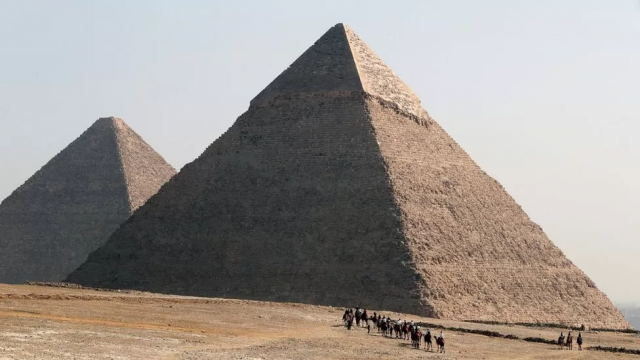A new ‘secret passage’ has been discovered in the Great Pyramid in the Giza area near Cairo, Egypt. It is evaluated as a decisive clue that indicates the possibility of something inside.
According to the British BBC and Associated Press on the 2nd (local time), the Egyptian Antiquities Authority held a press conference in front of the Great Pyramid and announced that they had “successfully discovered and filmed a secret passage from the north side.”
The newly discovered passage is located 7m above the main gate and is 2.1m wide and 9m long. The ceiling of the passage is in the shape of an inverted V with rocks leaning against each other at an angle.
This passage, which is blocked from the outside, was filmed with an endoscope camera.
The research team succeeded in photographing the interior space by pushing a 6mm endoscope through a small gap in the passage. However, the end of the passage was blocked by huge limestone, making it more difficult for the endoscope to enter.”
Archaeologist Zahi Hawass, who served as Egypt’s Minister of Antiquities, gave meaning to the pyramid, saying, “It can be a decisive clue to find out whether the real burial chamber of King Khufu exists inside the pyramid.”
“There is a high possibility that this passageway is protecting something. In my opinion, it seems to be guarding the real tomb of King Khufu.”
The Great Pyramid of Giza is the tomb of King Khufu, the second pharaoh of Egypt’s 4th Dynasty, and is estimated to have been built between 2609 and 2584 B.C. It is also called the ‘Pyramid of Khufu’ after the name of King Khufu. This pyramid was originally 146 meters high and is the largest of the three pyramids of Giza, hence the name ‘Great Pyramid’. It is considered one of the 7 wonders of the world.
 It is the largest of the three pyramids located in Giza.
It is the largest of the three pyramids located in Giza.Three burial chambers have been discovered so far in this pyramid, but no mummies or artifacts have been found there. There is a possibility that it may have suffered robbery damage, but the possibility that the actual tomb of King Khufu is hidden in a deeper place that is difficult for outsiders to access has been constantly raised.
To confirm this possibility, since 2015, Egyptian authorities have been conducting a ‘scan pyramid’ study with experts from France, Germany, Canada, Japan, etc. to find an empty place without destroying the pyramid.
Researchers are combing through the pyramids using various advanced technologies such as ground penetrating radar, ultrasound, and X-rays.
A detection technique using the elementary particle ‘muon’, which is formed when the cosmic background radiation meets the earth’s atmosphere, was also used. Muon has the property of penetrating several kilometers of rocks, so it is used for non-destructive building inspection.
Through this technology, the research team also discovered a 30-meter-long chamber that was sealed inside the pyramid in 2017.
Source: Donga
Mark Jones is a world traveler and journalist for News Rebeat. With a curious mind and a love of adventure, Mark brings a unique perspective to the latest global events and provides in-depth and thought-provoking coverage of the world at large.




